Seyfarth Synopsis: Roughly two years ago we introduced Seyfarth's Infographic tracking the spread of paid sick leave and anti-local sick leave laws around the country from pre-2014 to year-end 2018. We have since seen a torrential downpour of paid sick leave and derivative mandates, as well as some states' tireless efforts to fend off the storm. This update expands on our initial Infographic, tracking the expansion of paid sick leave laws, both in terms of geography and variations, over the last two years and examining the status of the nation's anti-local sick leave law stockpile.

At the end of 2018, the paid sick leave landscape consisted of a unique blend of leave and time off mandates. There were states with (a) only local paid sick leave mandates, (b) only a statewide paid sick leave mandate, or (c) both statewide and local paid sick leave mandates co-existing. Some statewide paid sick leave laws strip localities of the ability to regulate paid sick leave, while other states allow statewide and certain local paid sick leave mandates to coexist with an anti-local leave mandate.
A majority of the 2018 year-end "sick" leave laws and ordinances actually provided an amount of paid leave for reasons beyond just "sick" leave (e.g., an employee or family member's illness, injury, health condition). Among an array of unique location-specific covered absences, the most common covered absences outside of "sick" leave reasons involved "safe" leave (e.g., instances involving absences due to domestic violence, sexual assault, stalking, etc.). However, even though covered absences may have been broader than just "sick" leave, the scope of covered absences was limited. That changed in 2019 when multiple jurisdictions at both the state and local levels introduced paid personal leave mandates providing covered time off for any reason.
Providing no reprieve to employers navigating the paid sick leave patchwork, 2019 also saw the nation's first jurisdiction-specific separate paid sick and safe time mandates take effect. Beyond legislative developments, 2019 kept employers off balance with paid sick leave in the courtroom. Highlights included an ordinance that was supposed to debut in 2016 and then subsequently delayed for multiple years being brought back to life, and business-plaintiffs assailing three local ordinances in another state with identical arguments and wildly different outcomes.
Given 2019's paid sick leave contributions, employers expected 2020 would be an active year on the sick and personal leave front. Enter COVID-19. Suddenly, the already volatile paid sick and personal leave landscape morphed into a constant state of flux. In various ways, governments and administrative agencies at the federal, state, and local levels honed in on the use of paid sick leave as part of their COVID-19 response. Supplemental paid sick and personal leave mandates sprouted up without much, if any, warning, often going into effect immediately upon enactment. Certain locations amended their existing paid sick leave mandates to incorporate broader covered reasons for use with a focus on "public health emergency" related absences. A number of other jurisdictions released COVID-19 administrative guidance on their existing sick leave mandates, and then regularly updated that guidance throughout the calendar year. Finally, 2020 saw multiple states pass non-COVID-19 statewide mandates, a reminder to employers that even after the pandemic subsides, the sick leave patchwork will persist.
Thus, while the impact of COVID-19 on employers' paid sick and personal leave obligations, and operations more generally cannot be understated, general sick and personal leave mandates and the anti-local sick leave movement did not remain in lockdown. As we put it at the end of 2018, "[n]eedless to say, the paid sick leave landscape is constantly evolving." We welcome our returning readers to refresh their memories with our Pre-2014 through 2018 maps and specific points about the development of paid sick leave laws during each of the four relevant time periods, and our new readers to get caught up to speed on the same. For the main event, we have two new maps for 2019 and 2020 respectively, which follow the movement of paid sick and personal leave laws and ordinances and monitor the stamina on the anti-local leave law front.
I. Pre-2014

Note 1: Local paid sick leave mandates present in: (1) San Francisco, CA; (2) Long Beach, CA (covers certain hotel employers only); (3) Seattle, WA; and (4) Washington, D.C. Outside of these locations, and the state of Connecticut, paid sick leave was an area left to employer discretion.
Note 2: A majority of the nine state anti-local paid sick leave laws in effect prior to 2014 preempted localities from regulating a wide range of employment-related matters, such "employment benefits" or a related term (which generally includes time off benefits and leave), as opposed to expressly preempting localities from regulating sick leave.
Note 3: A paid sick leave ordinance was enacted in Milwaukee, WI in 2008. However, due to judicial and legislative delays, the ordinance had not yet gone into effect when Wisconsin passed its statewide anti-local paid sick leave law in 2011.
II. 2014-2015
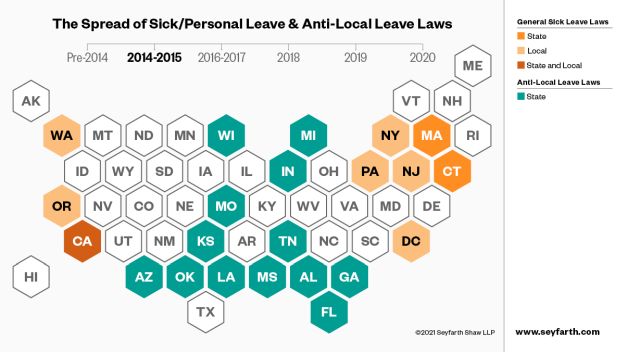
Note 1: In a matter of two years, the number of state and local paid sick leave laws around the country that were in effect or scheduled to go into effect increased from five to 23. The sick leave epidemic particularly impacted jurisdictions in the Northeast and Mid-Atlantic, and on the West Coast. To combat the epidemic, state anti-local paid sick leave laws emerged in four additional states.
Note 2: Local paid sick leave mandates present in: (1) San Francisco, CA; (2) Long Beach, CA (covers certain hotel employers only); (3) Oakland, CA; (4) Emeryville, CA; (5) Los Angeles, CA (covers certain hotel employers only); (6) Portland, OR; (7) Philadelphia, PA; (8) Jersey City, NJ; (9) Newark, NJ; (10) Passaic, NJ; (11) East Orange, NJ; (12) Paterson, NJ; (13) Irvington, NJ; (14) Montclair, NJ; (15) Trenton, NJ; (16) Bloomfield, NJ; (17) New York City, NY; (18) Seattle, WA; (19) SeaTac, WA (covers certain transportation and hospitality employers only); and (20) Washington, D.C.
Note 3: When California's statewide paid sick leave law went into effect, it became the first state in which both state and local paid sick leave mandates were imposed.
Note 4: During this time period, New Jersey municipalities added nine local paid sick leave mandates and became home to the greatest number of municipal sick leave ordinances of any state in country. New Jersey would retain this title until October 29, 2018.
Note 5: Pittsburgh, PA also passed a paid sick leave ordinance during this timeframe. It was scheduled to go into effect in early January 2016. However, it has not taken effect due to ongoing litigation regarding whether Pittsburgh could pass such an ordinance. The Pennsylvania Supreme Court heard oral arguments on the matter in October 2018.
III. 2016-2017
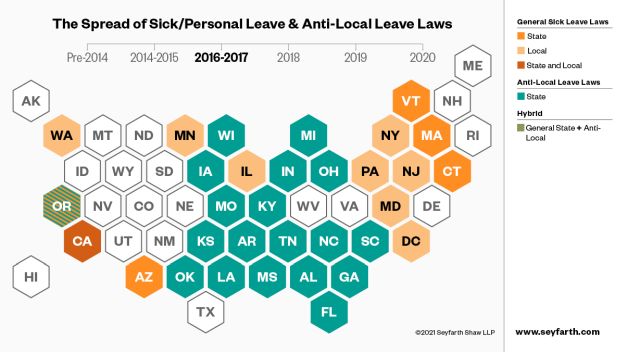
Note 1: During this 2016-17 window, the paid sick leave epidemic nearly doubled, increasing the number of laws with state or local mandates either in effect or scheduled to go into effect from 23 to 40. Notably, not only did the epidemic continue to intensify in the Northeast, Mid-Atlantic, and on the West Coast, but it also began spreading inward to Arizona and localities in Illinois and Minnesota. To combat the epidemic, state anti-local paid sick leave laws emerged in 7 additional states.
Note 2: Local paid sick leave mandates present in: (1) San Francisco, CA; (2) Long Beach, CA (covers certain hotel employers only); (3) Oakland, CA; (4) Emeryville, CA; (5) Los Angeles, CA (two ordinances - one covers certain hotel employers only and the other generally applies to private employers); (6) San Diego, CA; (7) Santa Monica, CA; (8) Berkeley, CA; (9) Chicago, IL; (10) Cook County, IL; (11) Montgomery County, MD; (12) Minneapolis, MN; (13) Saint Paul, MN; (14) Philadelphia, PA; (15) Jersey City, NJ; (16) Newark, NJ; (17) Passaic, NJ; (18) East Orange, NJ; (19) Paterson, NJ; (20) Irvington, NJ; (21) Montclair, NJ; (22) Trenton, NJ; (23) Bloomfield, NJ; (24) New Brunswick, NJ; (25) Elizabeth, NJ; (26) Plainfield, NJ; (27) Morristown, NJ; (28) New York City, NY; (29) Seattle, WA; (30) SeaTac, WA (covers certain transportation and hospitality employers only); (31) Spokane, WA; (32) Tacoma, WA; and (33) Washington, D.C.
Note 3: Oregon's statewide paid sick leave law came with an anti-local preemption vaccine, which eliminated the local strain that was in effect in Portland and had been enacted in Eugene.
Note 4: In 2013, the Arizona legislature enacted a preemption law, preempting a wide range of employment matters, including paid sick leave. The 2017 Arizona statewide paid sick leave law, however, expressly permits localities to enact more generous local paid sick leave mandates. See Ariz. Rev. Stat. §§ 23-378, 23-379(b). Given this language and questions surrounding the propriety of the preemption law in a more general context, it is very likely that localities may attempt to regulate paid sick leave in Arizona. See generally United Food & Com. Workers Local 99 v. State, No. CV 2016-092409, 2017 WL 8776461 (Ariz. Super. Ct. Aug. 30, 2017).
Note 5: The North Carolina law prohibiting local regulation of private employment practices (which likely includes sick leave) is set to expire on January 1, 2020.
Note 6: Ohio's paid sick leave preemption statute (Ohio Rev. Code Ann. § 4113.85) was enacted in 2016 via S.B. 331, a bill regulating a broad range of topics beyond preemption or employment law, and went into effect in March 2017. Many municipalities have filed lawsuits due to S.B. 331's broad sweep. At least two county courts in Ohio have found that the bill violates the Ohio Constitution's "one subject" clause and declared all provisions of S.B. 331 unrelated to pet store purchase supply regulation, the bill's original purpose, unconstitutional. Regardless, localities in Ohio are likely preempted from passing paid sick leave legislation because (1) Ohio Rev. Code Ann. § 4113.85 is in effect, (2) at least one intermediate appellate court case found that because the plaintiffs did not challenge paid sick leave preemption, but rather another provision, the issue of paid sick leave preemption was moot, and (3) the county court decisions do not bind other courts.
Note 7: On January 1, 2017, the federal contractor paid sick leave requirements, as set forth in Executive Order 13706 and the United States Department of Labor's corresponding Final Rule, went into effect, thereby providing paid sick leave benefits to many employees of certain federal contractors.
IV. 2018
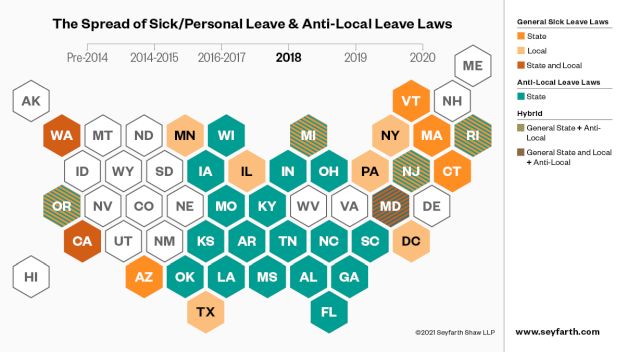
Note 1: 2018 saw the paid sick leave epidemic spread to only three additional localities. However, the epidemic continued to evolve and expand as five additional statewide sick leave mandates either went into effect or were enacted this year. The total number of paid sick leave mandates in effect or scheduled to go into effect at the time of our Initial Infographic at the end of 2018 was 35 (this figure excluded Pittsburgh, PA and Austin, TX in light of ongoing lawsuits challenging the cities' respective paid sick leave ordinances).
Note 2: Local paid sick leave mandates either in effect or scheduled to go into effect in: (1) San Francisco, CA; (2) Long Beach, CA (covers certain hotel employers only); (3) Oakland, CA; (4) Emeryville, CA; (5) Los Angeles, CA (two ordinances - one covers certain hotel employers only and the other generally applies to private employers); (6) San Diego, CA; (7) Santa Monica, CA; (8) Berkeley, CA; (9) Chicago, IL; (10) Cook County, IL; (11) Montgomery County, MD; (12) Minneapolis, MN; (13) Saint Paul, MN; (14) Duluth, MN; (15) New York City, NY; (16) Westchester County, NY; (17) Philadelphia, PA; (18) San Antonio, TX; (19) Seattle, WA; (20) SeaTac, WA (covers certain transportation and hospitality employers only); (21) Tacoma, WA; and (22) Washington, D.C.
Note 3: March 30, 2019 was the expected effective date of the Westchester County, NY paid sick leave ordinance because this date was 180 days from the date the paid sick leave bill was "adopted" according to the language of the ordinance and corresponding certification page from the Clerk of the Westchester County Board of Legislatures. However, there were multiple interpretations of the effective date that could have resulted in a slightly different effective date. The ordinance ultimately went into effect on April 10, 2019.
Note 4: The Duluth, MN paid sick leave ordinance went into effect on January 1, 2020.
Note 5: The Texas update is based on the following: The cities of Austin and San Antonio both passed paid sick leave ordinances in 2018. The Austin ordinance was originally scheduled to go into effect on October 1, 2018, while the San Antonio ordinance was scheduled to go into effect for most employers on August 1, 2019. In 2018, the Austin ordinance was involved in a lawsuit that found the ordinance to be unconstitutional. In addition, the Texas legislature previously introduced a bill that would prohibit all municipal paid sick leave ordinances in the state. However, as of 2018 year end, the lawsuit did not impact San Antonio and the status of the preemption bill was unclear (the preemption bill ultimately was not passed in 2019). As a result, as of 2018 year end, at least San Antonio's paid sick leave ordinance was still "scheduled to go into effect" in August 2019.
Note 6: Like the California statewide paid sick leave law, the Washington statewide paid sick leave law, which went into effect on January 1, 2018, does not preempt municipalities within the state from passing more generous paid sick leave mandates.
Note 7: The Spokane, WA paid sick leave ordinance's "sunset" provision took effect on January 1, 2018, and thus the Spokane ordinance is no longer in effect.
Note 8: Maryland's statewide paid sick leave law preempted its political subdivisions from passing paid sick leave ordinances on or after January 1, 2017. As a result, Montgomery County's paid sick leave ordinance, which went into effect in 2016, is still in effect and co-exists with the statewide paid sick leave law.
Note 9: When New Jersey's statewide paid sick leave mandate went into effect on October 29, 2018, the law preempted the state's 13 existing local paid sick leave ordinances and all future local New Jersey paid sick leave ordinances from being enacted.
Note 10: Michigan's statewide paid sick leave law was scheduled to go into effect in late-March 2019. As of 2018 year end, Michigan was the only state that (1) had a statewide paid sick leave mandate, and (2) preempted local paid sick leave ordinances via a law other than the statewide paid sick leave mandate. Michigan had prohibited local paid sick leave mandates since 2015, and thereafter passed its statewide paid sick leave law in 2018.
For the main event, we have two new maps for 2019 and 2020 respectively, which follow the movement of paid sick and personal leave laws and ordinances and monitors the stamina on the anti-local leave law front.
V. 2019
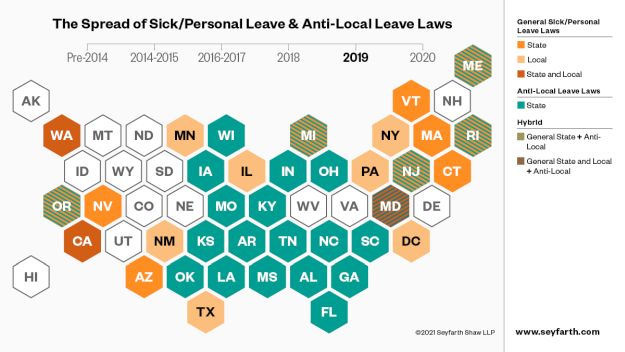
Note 1: At the end of 2019, the total number of paid sick/personal leave mandates either in effect or scheduled to go into effect had increased from 35 at the end of 2018 to 40 (this figure excludes Austin, TX and San Antonio, TX, which had been enjoined in ongoing lawsuits challenging the cities' respective paid sick leave ordinances). While a passerby might look at the numbers and see a plateau, the circumstances surrounding the 2019 developments suggest quite the opposite.
Note 2: Local paid sick/personal leave mandates (plus Washington, D.C.) either in effect or scheduled to go into effect include: (1) San Francisco, CA; (2) Washington, D.C.; (3) Seattle, WA; (4) Long Beach, CA (hotel-specific law); (5) SeaTac, WA (hospitality and transportation industry-specific law); (6) New York City, NY; (7) Los Angeles, CA (1 general law, and 1 hotel-specific law); (8) Oakland, CA; (9) Philadelphia, PA; (10) Tacoma, WA; (11) Emeryville, CA; (12) Montgomery County, MD; (13) Pittsburgh, PA; (14) Santa Monica, CA; (15) Minneapolis, MN; (16) San Diego, CA; (17) Chicago, IL; (18) Berkeley, CA; (19) Saint Paul, MN; (20) Cook County, IL; (21) Duluth, MN; (22) Westchester County, NY (1 sick leave law, 1 safe leave law); (23) Dallas, TX; (24) Bernalillo County, NM (personal leave law).
Note 3: On May 28, 2019, Governor Janet Mills of Maine signed the Earned Paid Leave Law-the nation's first paid time off mandate requiring employers to allow employees to use earned paid time off for any reason. The law ultimately went into effect on January 1, 2021. The law also prohibits municipalities or other political subdivisions from enacting any ordinance or other rule regulating earned paid leave, resulting in an anti-local leave mandate in Maine as well.
Note 4: Shortly after the enactment of Maine's paid sick/personal leave law, the Nevada Paid Leave Law was enacted in June 2019. Like the Maine law, the Nevada Paid Leave Law also requires employers to allow employees to use available paid leave for any reason. When the Nevada Paid Leave Law took effect on January 1, 2020, it became the first jurisdiction in the United States with a fully operative paid personal leave mandate impacting private employers.
Note 5: In August 2019, Bernalillo County, NM became the first local jurisdiction to enact a mandatory paid time off ordinance, providing leave for any reason and covering employers with employees in the unincorporated portions of the County. Amendments to the ordinance later in the year did not extend similar requirements to employers in the incorporated portions of the County, despite the County considering such an expansion. Thus, the noteworthy exemption for City of Albuquerque, NM employers (and employers in other incorporated areas of the County) remained. While the Bernalillo County ordinance had originally been scheduled to take effect on July 1, 2020, its effective date was ultimately delayed until October 1, 2020 due to the COVID-19 pandemic. Recently, the City of Albuquerque, NM similarly voted on a proposed paid time off ordinance, with the result being to defer the bill until February 1, 2021.
Note 6: The Westchester County, NY Earned Sick Leave Law ("ESLL"), which was enacted in 2018 and went into effect on April 10, 2019, notably did not contain "safe" time provisions. This was unlike a number of other recently enacted or amended paid sick leave laws and ordinances throughout the United States, including, in the immediate vicinity, the New York City Earned Safe and Sick Time Act and the New Jersey Earned Sick Leave Law. An explanation for the missing safe time provisions appeared in May 2019 when the County passed the Safe Time Leave Law ("STLL"). This enactment made Westchester County the first jurisdiction in the country to impose mandatory paid safe leave obligations on covered employers that are separate and apart from the jurisdiction's mandatory sick time obligations. Unlike existing paid sick leave laws and ordinances, including the Westchester County ESLL, the STLL did not contain accrual or carryover provisions. Closer to its October 30, 2019 effective date, the STLL FAQs confirmed there is no accrual of safe time leave, and covered employees are entitled to take up to 40 hours of paid safe time leave per year.
Note 7: The Dallas PSL ordinance was enacted in April 2019, and like the San Antonio PSL ordinance, was scheduled to go into effect on August 1, 2019. In July 2019, separate lawsuits to enjoin both ordinances were filed in a Bexar County district court and the U.S. District Court for the Eastern District of Texas, respectively. The lawsuits sought an enjoinment of the relevant PSL ordinances on the same grounds as those relied on by the Texas Court of Appeals for the Third District ("Third District") to temporarily enjoin the Austin PSL ordinance. The parties in the San Antonio case agreed to stay enforcement of the San Antonio PSL ordinance and the related litigation while considering next steps in the coming months, while the Dallas PSL ordinance went into effect on August 1 despite the lawsuit filed to enjoin it.
In October 2019, the City of San Antonio amended its PSL ordinance. The corresponding litigation re-commenced and the San Antonio PSL ordinance, as amended, was temporarily enjoined in late 2019 on the same grounds as relied on to enjoin the Austin PSL ordinance in 2018. As the year came to a close, the City of Austin's appeal of the Third District's decision remained before the Texas Supreme Court, which had ordered briefs on the merits but had not decided whether or when it would hear the case. The federal district court hearing the case on the Dallas PSL ordinance had ruled on issues such as venue, but had not yet ruled on whether to temporarily enjoin the Dallas PSL ordinance on constitutional grounds. As a result, as of the end of 2019, the Dallas PSL ordinance remained in effect, while the San Antonio and Austin PSL ordinances remained temporarily enjoined.
Note 8: In July 2019, the Pennsylvania Supreme Court reversed 2015 and 2017 state trial and appellate court decisions ruling that Pittsburgh's PSL ordinance - the Paid Sick Days Act ("PSDA") that had been scheduled to go into effect in January 2016 - violated the state Home Rule Charter and Optional Plans Law ("Home Rule Law"). Notably, the decision did not appear to address when the PSDA would take effect as a result of the reversal. Finally, in December 2019, the City of Pittsburgh released PSDA Guidelines and announced that the ordinance would take effect on March 15, 2020.
VI. 2020
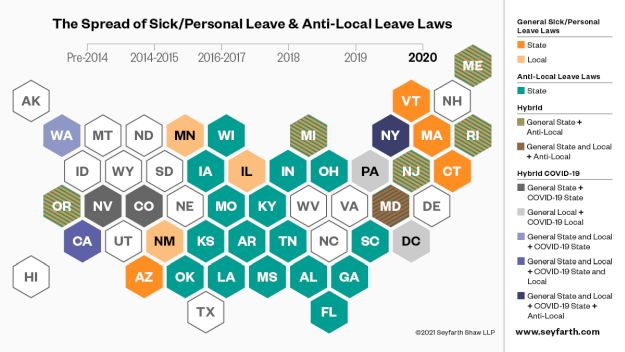
Note 1: 2020 saw an exponential increase in the complexity and number of paid sick/personal leave mandates, with the COVID-19 pandemic serving as the driving force behind a vast majority of developments. Throughout 2020, employers were faced with 66 paid sick/personal leave mandates arising out of 46 jurisdictions at the federal, state, and local level that were either (a) in effect at this time; (b) in effect at some point in 2020; or (c) scheduled to go into effect at a later time (this figure excludes Austin, TX, San Antonio, TX, and Dallas, TX, all of which remain enjoined in ongoing lawsuits challenging the cities' respective paid sick leave ordinances). The status of certain COVID-19 specific paid sick leave mandates is current as of January 7, 2021. Further, only two of the mandates that appeared during this time period provide for non-COVID-19 or non-public health emergency related paid leave benefits. Meanwhile, the landscape for anti-local sick and/or personal leave largely remained the same, with the exception of one mandate expiring during this time period and one mandate preempting local paid sick and safe leave laws in-part.
Note 2: Local paid general or COVID-19 sick/personal leave mandates (plus Washington, D.C.) in effect in 2020 include: (1) San Francisco, CA; (1 general sick leave law; 1 COVID-19 leave law) (2) Washington, D.C. (1 general sick leave law; 1 COVID-19 leave law); (3) Seattle, WA (1 general sick leave law; 1 general sick leave law - temporary, emergency basis for gig workers); (4) Long Beach, CA (1 hotel-specific general sick leave law; 1 COVID-19 leave law); (5) SeaTac, WA (hospitality and transportation industry-specific law); (6) New York City, NY; (7) City of Los Angeles, CA (1 general sick leave law; 1 hotel-specific general sick leave law; 1 COVID-19 leave law); (8) Oakland, CA (1 general sick leave law; 1 COVID-19 leave law); (9) Philadelphia, PA; (1 general sick leave law; 1 COVID-19 leave law); (10) Tacoma, WA; (11) Emeryville, CA; (12) Montgomery County, MD; (13) Pittsburgh, PA (1 general sick leave law; 1 COVID-19 leave law); (14) Santa Monica, CA; (15) Minneapolis, MN; (16) San Diego, CA; (17) Chicago, IL; (18) Berkeley, CA; (19) Saint Paul, MN; (20) Cook County, IL; (21) Duluth, MN; (22) Westchester County, NY (1 sick leave law, 1 safe leave law); (23) Bernalillo County, NM (personal leave law); (24) Los Angeles County, CA (COVID-19 leave law); (25) City of Sacramento, CA (COVID-19 leave law); (26) Sacramento County, CA (COVID-19 leave law); (27) San Jose, CA (COVID-19 leave law); (28) San Mateo County, CA (COVID-19 leave law); (29) Santa Rosa, CA (COVID-19 leave law); and (30) Sonoma County, CA (COVID-19 leave law).
Note 3: On March 11, 2020, Colorado became the first jurisdiction to pass a COVID-19 leave mandate with the adoption of the Temporary Health Emergency Leave with Pay ("HELP") Rules. The HELP Rules initially provided 4 calendar days of leave to employees working in a limited number of industries with flu-like symptoms who were being tested for COVID-19, and through multiple amendments and re-adoptions, ultimately provided 2 weeks (up to 80 hours) of COVID-19 leave to employees in a far broader range of industries (e.g., office work) for flu-like or respiratory illness symptoms and who were getting tested for COVID-19 or under instruction to quarantine or isolate from proper government officials or a healthcare provider. The HELP Rules were ultimately terminated on July 14, 2020 in place of the Colorado Healthy Families and Workplaces Act ("HFWA"), which was enacted at the same time with broader COVID-19 leave requirements, general sick leave requirements, and more. See Note 17 below for further information on the HFWA.
Note 4: At the start of the year, New York State had its sights set on a statewide general sick leave law. However, with the arrival of COVID-19, the state first enacted a COVID-19 Emergency Leave Law, which went into effect on March 18, 2020. New York's COVID-19 mandate is without an expiration date, and depending on an employer's size, provides either unpaid sick leave, or 5 or 14 days of paid sick leave, when an employee is subject to a mandatory or precautionary order of quarantine or isolation due to COVID-19 issued by one of various state and local government health agencies. Employees may also be entitled to paid family or disability benefits, which are not covered in this Infographic. Soon after New York's COVID-19 leave was on the books, the state followed through with its general sick leave plans, enacting the New York State Paid Sick Leave Law on April 3, 2020. The statewide general sick leave mandate took effect on September 30, 2020 and presented a number of challenges for employers, albeit closer to that time. See Notes 26 and 27 below for further information on the New York State Paid Sick Leave Law and related developments.
Note 5: Monumentally, the Families First Coronavirus Response Act ("FFCRA") went into effect on April 1, 2020, requiring 2 weeks (up to 80 hours) of emergency sick leave for certain COVID-19-related absences at the federal level, as well as 10 weeks of more limited-use emergency family medical leave (not covered in this Infographic other than to the extent there is overlap with COVID-19 sick leave). With limited exceptions, the FFCRA applied to employers with fewer than 500 employees nationwide. Employees absence for a covered reason were paid either their regular rate of pay or 2/3 thereof, up to $511 or $200 daily caps and $5,110 or $2,000 aggregate caps depending on whether their use of COVID-19 leave is to care for themselves or another individual. While the FFCRA sick leave and expanded family medical leave payroll tax credits were extended through March 31, 2021, the FFCRA paid leave mandates were not extended and sunset at the end of 2020. Despite expiring on December 31, 2020, the impact of the FFCRA cannot be understated. As seen in a number of notes below, similarly structured mandates, one after another, would emerge out of jurisdictions looking to fill the federal law's coverage "gaps."
Note 6: Certain jurisdictions addressed COVID-19 by amending or expanding their existing general paid sick leave mandate to address the pandemic. On March 16, 2020, Philadelphia adopted emergency regulations providing COVID-19 specific reasons for use of employees' existing sick leave balances under Philadelphia's general sick leave law, and requiring conditions associated with use of such time. On March 18, 2020 and March 25, 2020, Seattle, WA and the State of New Jersey, respectively, amended their existing sick leave mandates to include certain public-health-related uses as protected uses of employees' existing general sick leave benefits. Notably, while the New Jersey and Seattle paid sick leave laws were amended in response to COVID-19, they appear to be permanent, as opposed to "temporary" amendments, and geared towards sick leave use in public health crises more generally. The Philadelphia emergency regulations remain in effect for the duration of the local disaster emergency declared by the Mayor of Philadelphia in response to COVID-19. See Note 23 below for further information on Philadelphia's separate supplemental COVID-19 leave mandate.
Note 7: Some jurisdictions responded more informally whether as their sole means of infusing sick leave requirements in light of COVID-19 or in addition to more formal COVID-19 oriented regulation. A number of administrative agencies responsible for sick/personal leave enforcement in their jurisdictions issued non-binding guidance or FAQs expanding on how their generally applicable sick or personal leave mandate applies in light of COVID-19 (e.g., an employee who uses general sick leave for medical diagnosis can use the leave to get tested for COVID-19). Interestingly and further complicating the COVID-19 leave landscape, some of this guidance came from health or other business regulatory agencies not responsible for enforcement of their jurisdiction's sick or personal leave mandate and applied to employer-provided leave more generally (as opposed to such leave required under applicable law). Nonexclusive examples of such informal oversight include: Arizona; California; Emeryville, CA; City of Los Angeles, CA; Oakland, CA; San Diego, CA; San Francisco, CA; Chicago, IL (PSL Agency Guidance and Department of Health Guidance); Cook County, IL; Maryland (Attorney General Office Guidance on Employment Laws and COVID-19); Massachusetts; Duluth, MN; Minneapolis, MN; Saint Paul, MN; Nevada; New York City, NY; Oregon; and Washington State.
Note 8: On April 7, 2020, San Jose, CA became the first jurisdiction to roll out a COVID-19 leave mandate intended to provide benefits to workers in the city not covered by the FFCRA. Unlike a number of jurisdictions that would shortly follow suit, the COVID-19 leave mandate was the first sick leave law in San Jose, CA. The ordinance generally provided the same amount of leave, allowed use for the same COVID-19-related reasons, and compensated employees for use of leave at the same rate as required by the FFCRA. While the Ordinance technically expired on December 31, 2020, it was reenacted on January 6, 2021 and will remain in effect through June 30, 2021, unless further extended.
Note 9: Also on approximately April 7, 2020, the City of Los Angeles, CA greeted employers with its third sick leave mandate. The COVID-19 leave order applies to employers with (a) 500 or more employees in Los Angeles or (b) 2,000 employees nationwide, and covers employees who worked in the City for the same employer between February 3, 2020 and March 4, 2020. Among other exemptions, the mandate most notably exempts a business that was closed or not operating for 14 or more consecutive calendar days due to a city official's emergency order related to COVID-19 on or after March 4, 2020. The amount of leave required is the standard FFCRA amount; however, the mandate contains slight deviations from the FFCRA-covered reasons for use. The City of Los Angeles order also departs from the FFCRA in that it did not expire at the end of 2020, and instead remains in place until 2 weeks after the expiration of the local emergency period.
Note 10: Washington, D.C.'s COVID-19 leave mandate - added as a near-standalone provision within the general D.C. sick leave law - also went into effect on April 10, 2020. Following a set of substantive amendments and some extended expiration dates, the mandate is set to remain in place until May 21, 2021; however, it only requires COVID-19 leave during the COVID-19 emergency, leaving open the potential for an earlier expiration of the District's COVID-19 leave requirements. The mandate applies to employers with between 50-499 employees, although it is not clear whether an employer should count D.C. employees only or all employees within the United States. The D.C. COVID-leave amount, while the same as required under the FFCRA and most derivatives, is (1) paid at the employee's regular 2-week pay without any daily or aggregate cap, and (2) can only be used concurrently with or after exhaustion of leave provided under federal or district law or employer policy more generally that can also be used for COVID-19 covered reasons, with the employee choosing one or the other.
Note 11: The San Francisco, CA Public Health Emergency Leave Ordinance went into effect on April 17, 2020. Unless reenacted (which has occurred multiple times thus far), the ordinance will sunset on February 11, 2021 or upon the termination of the public health emergency, whichever occurs first. San Francisco's second paid leave ordinance covers employers with 500 or more employees nationwide who are not covered by the FFCRA. The 2 weeks (up to 80 hours) of COVID-19 related leave required is in addition to any employer-provided paid leave prior to April 17 (including in compliance with the general sick leave ordinance), although potential offsets are available. Like other local COVID-19 leave ordinances, San Francisco's COVID-19 leave ordinance expands on COVID-19 related absences permitted under federal law. It also provides leave at full pay and generally up to the same amount of COVID-19 leave as required for employees who work at least 40 hours per week under the FFCRA and a prorated amount for employees who work fewer hours per week.
Note 12: Unlike the City of Los Angeles, California's Los Angeles County does not have a general sick leave ordinance either in effect or scheduled to go into effect. However, following the city's footsteps with respect to COVID-19, on April 28, 2020, the county passed a COVID-19 leave ordinance that requires employers with 500 or more employees nationally to provide 2 weeks (up to 80 hours) of leave for certain COVID-19 related covered absences to employees working in the unincorporated portions of Los Angeles County. While the ordinance technically expired on December 31, 2020, the County Board of Supervisors is expected to extend the ordinance later in January 2021.
Note 13: Building on the surge of COVID-19 leave mandates from California localities, on May 12, 2020, the City of Oakland padded the sick leave required under the city's local general sick leave mandate with up to 80 hours (and a prorated amount for employees who work fewer than 40 hours per week) of additional leave for reasons related to COVID-19, including additional reasons not covered under the FFCRA. When using COVID-19 leave, employees must be paid full pay and not less than the city minimum wage, subject to a $511 daily cap and $5,110 aggregate cap, regardless of the reasons for use. Notably, the Oakland COVID-19 leave ordinance also requires that employees laid off on or after May 12, 2020 have their general sick leave balances paid out, despite no requirement for such payout under the city's general sick leave mandate. The Oakland COVID-19 leave mandate expired on December 31, 2020. It is unclear whether it will be extended by the Oakland City Council.
Note 14: Then, on approximately May 19, 2020, Long Beach, CA passed its first non-industry-specific sick leave ordinance, providing 2 weeks (up to 80 hours) of COVID-19 related leave to employees of employers not covered by the FFCRA in whole or in part working in the city. The ordinance contains rate of pay and cap requirements similar to those under the FFCRA, and is not set to expire on any particular date. Rather, the ordinance expires upon the Long Beach City Council's determination it is no longer needed - an assessment that is required every 90 days.
Note 15: The City of Santa Rosa, CA's first sick leave ordinance went into effect on July 7, 2020 and requires employers not covered by the FFCRA in whole or part to provide 2 weeks (up to 80 hours) of COVID-19 related leave. Unlike under the FFCRA, the rate of pay required when an employee takes COVID-19 leave is the employee's regular rate, subject to a $511 daily cap and $5,110 aggregate cap, regardless of the reason for use. The Santa Rosa COVID-19 leave mandate expired on December 31, 2020. It is unclear at this time whether it will be extended.
Note 16: The next day, on July 8, 2020, the first sick leave ordinance in San Mateo County, CA became effective, requiring employers with 500 or more employees nationwide to provide employees in the unincorporated portions of the county with 2 weeks (up to 80 hours) of COVID-19 leave for reasons largely similar to those covered under the FFCRA. Unlike the FFCRA, the ordinance requires that employees be paid their regular rate of pay for COVID-19 leave, subject to a $511 daily cap and $5,110 aggregate cap, regardless of the reason for use. While the ordinance was originally scheduled to expire on December 31, 2020, on December 8, the San Mateo County Board of Supervisors extended the ordinance to remain in place until June 30, 2021, unless further extended.
Note 17: On July 14, 2020, Colorado enacted a statewide paid sick leave law - the Healthy Families and Workplaces Act - making it the 15th state with a general, permanent sick leave mandate either in effect or scheduled to go into effect at a later time. From that date until December 31, 2020, all Colorado employers, regardless of size, were required to provide paid leave in the amount and for the reasons required under the FFCRA to employees not eligible for such benefits under federal law. The law's general sick leave provisions took effect for most employers on January 1, 2021. Also beginning on January 1, 2021, and on each subsequent date on which a date a public health emergency ("PHE") - defined as (A) an act of bioterrorism, a pandemic influenza, or an epidemic caused by a novel and highly fatal infectious agent, for which: (I) an emergency is declared by a federal, state or local public health agency; or (II) a disaster emergency is declared by the Governor; or (B) a highly infectious illness or agent with epidemic or pandemic potential for which a disaster emergency is declared by the Governor - is declared, employers must provide employees with a one-time grant of 2 weeks (up to 80 hours) of sick leave for certain reasons related to the PHE. Employees can use this PHE sick leave - which accounts for any amended, extended, restated, or prolonged declaration of the initial PHE declared - until 4 weeks after the PHE's official termination. Upon a public health emergency declaration, employees' general sick leave accruals can be counted towards the PHE sick leave allowance and used for either general or PHE reasons.
Note 18: The first sick leave ordinance to arrive in the City of Sacramento, CA was enacted on June 30, 2020, went into effect on July 15, 2020, requiring employers with 500 or more employees nationwide who are not covered under the FFCRA to provide most employees in the city with 2 weeks (up to 80 hours) of COVID-19 leave, including for additional reasons not covered under federal law. The ordinance contains rate of pay and cap requirements similar to those under the FFCRA in that COVID-19 leave is paid at an employee's regular rate and capped at $511 per day and $5,110 in the aggregate, except when used to care for a family member, the requirement is 2/3 of the regular rate, capped at $200 per day and $2,000 in the aggregate. While the ordinance was scheduled to expire on December 31, 2020, legislation to further extend the ordinance resulted in an extension until at least March 31, 2021.
Note 19: A near-identical ordinance was passed by the Sacramento County Board of Supervisors on September 1, 2020, with provisions requiring COVID-19 leave for employees working in the unincorporated portions of the County. The County ordinance became effective October 1, 2020 (although employer obligations did not take effect until October 15) and was scheduled to expire on December 31, 2020. After what appears to have been a brief sunset at 2020 year-end, the ordinance is scheduled to take effect again on January 14, 2021, and remain in effect until at least March 31, 2020.
Note 20: On August 11, 2020, the state of Nevada passed a law requiring employers operating "public accommodation facilities" (defined as a hotel and casino, resort, hotel, motel, hostel, bed and breakfast facility or other facility offering rooms or areas to the public for monetary compensation or other financial consideration on an hourly, daily or weekly basis) to provide employees with between 3-14 days of COVID-19 related leave for certain covered reasons, with the amount depending on the nature of the covered absence. Such leave is required in addition to personal leave required under Nevada's general paid personal leave law (discussed in Note 4 under 2019 map above), which cannot be counted toward employers' COVID-19 leave obligations.
Note 21: On August 18, 2020, the state of Washington issued a proclamation requiring employers to provide certain "food production workers" not covered by the FFCRA with 2 weeks (up to 80 hours) of leave for certain COVID-19 related covered absences, even if not "employees." This proclamation expired on November 13, 2020.
Note 22: Sonoma County, CA's first sick leave ordinance went into effect on August 18, 2020, requiring employers with 500 or more employees nationwide who are not covered under the FFCRA to provide most employees in the unincorporated portions of the County with 2 weeks (up to 80 hours) of COVID-19 leave, for reasons largely paralleling those covered under federal law. Unlike the FFCRA, the rate of pay required when an employee takes COVID-19 leave under the County ordinance is the employee's regular rate, subject to a $511 daily cap and $5110 aggregate cap, regardless of the reason for use. The Sonoma County COVID-19 leave mandate originally expired on December 31, 2020. While the County announced an extension of COVID-19 leave benefits on its website, it is unclear whether this extension applies to only public employees in the County or to private employees as well (although appears to only apply to the former). Thus, it is unclear at this time whether the benefits for private employees have formally been extended into 2021.
Note 23: On September 17, 2020, Philadelphia, PA's second sick leave mandate took effect, requiring that employers provide "covered individuals" (includes certain non-employee workers) not covered by the FFCRA with 2 weeks (up to 112 hours) of leave at their regular pay rate for certain reasons during a public health emergency (defined as declared or proclaimed emergency related to a public health threat, risk, disaster or emergency that affects Philadelphia that is made or issued by a federal, state or local official with the authority to make or issue such a declaration or proclamation). The Philadelphia public health emergency leave mandate expired on December 31, 2020. It is unclear at this time whether it will be extended.
Note 24: Initially, the state of California only provided COVID-19 leave to certain "food sector workers" via Executive Order N-51-20 (signed April 16, 2020), covering employers with 500 or more employees nationwide. Such protections were codified into law for both food sector and non-food-sector employees (including health care workers and first responders excluded by their employers from the FFRCA), and went into effect on September 19, 2020 for non-food sector workers. Employers must provide food-sector workers, as well as other covered employees, with 2 weeks (up to 80 hours) of paid leave for a limited set of COVID-19 related reasons involving the worker/employee, and not including care of family members. While COVID-19 leave is required in addition to employer provided leave in general (including the state's general sick leave law), certain offsets are permitted. California state's COVID-19 leave provisions for all individuals expired on December 31, 2020, consistent with the FFCRA's sunset. It is unclear at this time whether California COVID-19 supplemental paid sick leave will be extended.
Note 25: In addition, the California Department of Industrial Relations' Office of Administrative Law approved a California OSHA emergency temporary standard ("ETS") regarding COVID-19, effective November 30, 2020. The ETS mandates that when employees are excluded from work for certain COVID-19 related reasons (i.e., having, or having been exposed to COVID-19), but remain "otherwise able and available to work, employers shall continue and maintain an employee's earnings, seniority, and all other employee rights and benefits, including the employee's right to their former job status," notably without reference to any caps on the amount of leave or monetary compensation required, and without employer coverage standards based on headcount (e.g., 500 or more employees nationwide). The ETS does not apply where the employer demonstrates the COVID-19 exposure is not work-related.
Note 26: The New York statewide general paid sick leave mandate went into effect on September 30, 2020, and marked the second statewide sick leave law in the state (see Note 4 above). Additionally, New York City employers remain subject to the city's general paid sick leave law, which was amended effective September 30, 2020, predominantly to align with the new statewide general sick leave mandate. Westchester County, NY employers remain subject to at least the local safe time mandate (discussed in 2019 Note 6 above). Despite no known explicit action County legislature, the County Human Rights Commission, which aids in enforcement of both the sick and safe time mandates, posted language on its Earned Sick Leave Law webpage suggesting that the County sick leave ordinance is no longer in effect in light of the statewide general sick leave mandate while its separate Safe Time Leave Law remains in effect.
Note 27: In terms of anti-local leave and sick leave mandates in existence and going forward in the Empire State, the New York State general sick leave law provides "[n]othing in this section shall be construed to prevent a city with a population of one million or more from enacting and enforcing local laws or ordinances which meet or exceed the standard or requirements for minimum hour and use set forth in this section, as determined by the commissioner. Any paid sick leave benefits provided by a sick leave program enforced by a municipal corporation in effect as of the effective date of this section shall not be diminished or limited as a result of the enactment of this section."
Note 28: Pittsburgh, PA's second sick leave ordinance went into effect on December 9, 2020 and expirers upon the official termination or suspension of the state or local emergency disaster declaration, whichever is sooner. Employers with 50 or more employees (unclear whether employees in City of Pittsburgh only or nationwide should be counted) must provide covered employees with (1) 2 weeks (up to 80 hours) of leave for covered absences related to COVID-19 (in addition to sick leave required under general ordinance) until 1 week after the official termination or suspension of the state or local emergency disaster declaration, whichever is sooner); and (2) the maximum amount of general sick leave available to employees under the local general sick leave ordinance immediately upon hire, if a permissible request for use of such time arises directly from COVID-19.
Note 29: While not a distinct COVID-19 leave mandate at the state level, starting April 3, 2020 and continuing through August 2020, Michigan had seen a number of executive orders requiring employers to permit employees absences for certain reasons related to COVID-19 without adverse consequences. For some time, employers were required to permit employees to use sick leave provided under Michigan's general statewide sick leave law for such absences as may be available, and if no general sick leave was available, provide the COVID-related leave unpaid. However, due to an October 2020 Michigan Supreme Court ruling against the Governor's authority to issue COVID-19 related health orders, such employer-obligations no longer exist in Michigan.
Note 30: Outside of imposing requirements on employer-provided leave related to COVID-19 and regardless of any such leave, the following sick leave jurisdictions also have in effect laws and ordinances prohibiting adverse action against employees out of work due to COVID-19 infection and/or abiding by orders from appropriate officials/professionals directed at the employee to reduce the spread of COVID-19: (1) State of New Jersey (Effective March 20, 2020 - End of COVID-19 Public Health Emergency/State of Emergency Declaration); (2) State of Maryland (Effective March 19, 2020 - April 30, 2021); (3) Chicago, IL (Effective May 20, 2020); and (4) San Francisco, CA (Effective September 11, 2020 - January 9, 2021, unless re-extended).
Note 31: At this time, none of three local sick leave ordinances in Texas (i.e., Austin, Dallas, and San Antonio) are in effect as all have been temporarily enjoined as part of three separate ongoing lawsuits (see Note 7 of 2019 map). First, on March 30, 2020, a federal district court ordered a temporary injunction of the Dallas PSL Ordinance - which had taken effect on August 1, 2019, but had not been enforced apart from its retaliation provisions given an April 1, 2020 "grace period" provision. Second, on June 5, 2020, the Supreme Court of Texas denied the City of Austin's petition for review in its sick leave ordinance litigation, in a one-line decision without any substantive opinion or analysis on the constitutionality of local sick leave ordinances and state law preemption of the same. As a result, the Third District's decision - which does not bind courts outside its jurisdictions - temporarily enjoining the Austin ordinance on constitutional grounds has stood to date. Third, the San Antonio sick leave litigation continues. The Texas Court of Appeals for the Fourth District reinstated the City of San Antonio's appeal of the temporary injunction of its sick leave ordinance, with the formal submission of briefs completed on October 21, 2020.
Note 32: North Carolina's anti-local leave mandate, providing "[n]o local government in this State may enact or amend an ordinance regulating private employment practices" expired on December 1, 2020.
The content of this article is intended to provide a general guide to the subject matter. Specialist advice should be sought about your specific circumstances.





